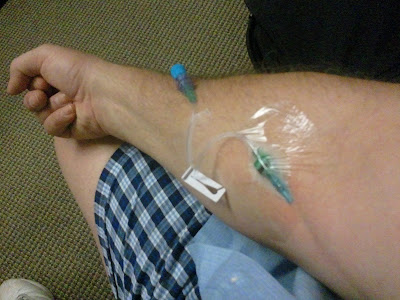Accurate as it may be, however, “silent” is something of a misnomer. I presume it is used instead of “painless,” which would sound misleadingly benign. Whether it comes with searing chest pains or simple shortness of breath, a heart attack is a heart attack. But it may not always be what you’d expect, as I recently found out.
What the
 so-called silent attack lacks in drama it makes up for in mystery and angst. If you’re in otherwise good health and wake up one morning unable to breathe, you can’t necessarily be sure what’s going on unless you’re predisposed to an awareness of the more subtle effects that can accompany a heart attack. It may not occur to you to go to the insufferable ER but if you’re lucky your primary care doc might be able to see you right away, as mine did most mercifully.
so-called silent attack lacks in drama it makes up for in mystery and angst. If you’re in otherwise good health and wake up one morning unable to breathe, you can’t necessarily be sure what’s going on unless you’re predisposed to an awareness of the more subtle effects that can accompany a heart attack. It may not occur to you to go to the insufferable ER but if you’re lucky your primary care doc might be able to see you right away, as mine did most mercifully.If he or she is on the ball they may pick up on the telltale signs (like a BP of 189/120) and start you on an ACE inhibitor (e.g. Lisinopril – “to treat high blood pressure, congestive heart failure, and to improve survival after a heart attack”) & Lasix along with 4 or 5 other drugs, while ordering a battery of tests to find out what’s actually causing you to feel so weird: short-of-breath, restless, fatigued, unfocused and generally out-of-sorts. Tests may include blood draws, multiple EKGs, echocardiograms, various sonograms, a nuclear stress test & cardiac catheterization, all to be reviewed by a good cardio specialist who can hopefully make sense of what’s bugging you at last, and help you decide what to do about it.
Before getting to that point, while sloughing through all these tests & assessments you are likely to hear one wildly conflicting opinion after another about your chances of dropping dead at any minute or it all just being a fluke of nature that you’ll get over with a few changes in habits & lifestyle. Even if you usually feel, as I do, like you’ve had a good run and whatever happens happens, the resulting uncertainty can be quite distressing and it may be a good idea to ask your doctor to prescribe some kind of psychotropic and/or anti-anxiety med along with everything else you’re on -- jus
 t to keep yourself from freaking out. I found low dose Klonipin and Celexa to do the trick.
t to keep yourself from freaking out. I found low dose Klonipin and Celexa to do the trick.If by chance, during this time you also happen to have a previously-scheduled appointment with your optometrist for new glasses, you may even get independent confirmation that something is amiss, which you might have otherwise missed. As your eyes show no outward sign of redness, who would have thought to look directly behind your corneas to find that they are hemorrhaging like crazy? If you have a day to spend after this in your local eye hospital being examined by a team of ophthalmologists you might get to see the most amazing 3-D spectral images depicting geysers of bright red blood gushing from the backside of your orbs! That can’t be good but it does add to the evidence of your condition.
Of course you may never have the opportunity to experience any of this fun stuff if you don’t have the good fortune of being employed by a company or organization that provides decent healthcare benefits. If I weren’t so lucky I may well have not made it past day one of this scenario. Having lived at both ends of the U.S. healthcare spectrum I have such an aversion to avoiding encounters with any emergency room that I would rather just let nature take its course than try to live through the trauma & maltreatment of the welfare-dependent heart patient I might otherwise be today. As it is, I’m in the very capable hands of a crack medical team that has me feeling better than I have any right to feel, given my diagnosis.
By all indications, it turns out that I did have a “silent” heart attack about a month ago – one that’s been coming on for the last several years, as I may have known if I were paying attention to certain symptoms and effects that were routinely dismissed as anything other than heart disease: “the Number One Killer of Americans today.” Not that I blame anybody for missing it – I’ve personally found that denial has always been a very effective coping mechanism, as far as it goes. If it weren’t for the confluence of those streams of fortune or whatever may be responsible for landing me in my current situation, I might already be toast. And the best that could come of my experience would be as a lesson to those who might be thereby compelled to pay attention earlier to this killer’s stealth indicators.
 As it is, I’m currently faced with the decision of how to deal with the progressive mitral regurgitation, which “may begin suddenly, most often after a heart attack” (Medline Plus, 2011) and my annoyingly enlarged left ventricle. It’s a deadly combination if I do nothing but I’m told that the meds I’m on & the “lifestyle changes” I’ve already made will keep me viable long enough for the docs & me to decide which kind of surgical intervention will be best: valve repair or replacement.
As it is, I’m currently faced with the decision of how to deal with the progressive mitral regurgitation, which “may begin suddenly, most often after a heart attack” (Medline Plus, 2011) and my annoyingly enlarged left ventricle. It’s a deadly combination if I do nothing but I’m told that the meds I’m on & the “lifestyle changes” I’ve already made will keep me viable long enough for the docs & me to decide which kind of surgical intervention will be best: valve repair or replacement.My own research on the subject has me leaning strongly toward a repair job, which is much less invasive and considered the safest alternative in the early stages of this syndrome. If anything is clear, as a degenerative condition it’s not going to fix itself.
If I do need a replacement sooner rather than later I’ve already decided I’m putting in for a pig valve. I hear they’re the best.
Oink!
References
American Heart Association (2011). Silent Heart Attack http://www.silentheartattack.org/
http://www.heart.org/HEARTORG/
Medline Plus (2011). Mitral regurgitation – chronic. Website viewed 07/11/2011; http://www.nlm.nih.gov/medlineplus/ency/article/000176.htm
Suri RM, et al (2011). Management of less-than-severe mitral regurgitation: should guidelines recommend earlier surgical intervention? Eur J Cardiothorac Surg, doi:10.1016/j.ejcts.2010.11.068
Karalis D (2011). Pathophysilolgy of valvular heart disease, Drexel University College of Medicine, handout
Yuksel UC, Kapadia SR and Tuzcu EM (2011). Percutaneous mitral repair: patient selection, results, and Future directions, Curr Cardiol Report, 13:100-106. doi 10.1007/s11886-010-0158-x
Medline Plus (2011). Mitral regurgitation – chronic. Website viewed 07/11/2011; http://www.nlm.nih.gov/medlineplus/ency/article/000176.htm
Suri RM, et al (2011). Management of less-than-severe mitral regurgitation: should guidelines recommend earlier surgical intervention? Eur J Cardiothorac Surg, doi:10.1016/j.ejcts.2010.11.068
Karalis D (2011). Pathophysilolgy of valvular heart disease, Drexel University College of Medicine, handout
Yuksel UC, Kapadia SR and Tuzcu EM (2011). Percutaneous mitral repair: patient selection, results, and Future directions, Curr Cardiol Report, 13:100-106. doi 10.1007/s11886-010-0158-x







